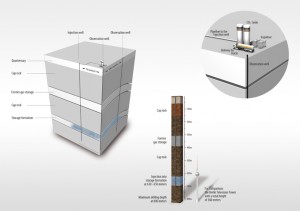Welcome to week two of GeoCinema Screenings!
In a time when we can’t escape the fact that anthropogenic emissions are contributing to the warming of the Earth, we must explore all the options to reduce the impact of releasing greenhouse gases into the atmosphere. The three films this week tackle the challenge of separating CO2 from other emissions and then storing it in geological formations deep underground (Carbon Capture and Storage, CCS).

Infografics of the CO2 Storage at the pilot site in Ketzin (modified after: Martin Schmidt, www.starteins.de) Credit: http://www.co2ketzin.de/nc/en/home.html
Geological Conditions and Capacities
Porous rocks with good permeability have, in Germany and world-wide, the highest potential for geological CO2 storage. Where do these rocks occur? And which further criteria do potential CO2 storage sites need to meet?
Ketzin Pilot Site
At the Ketzin pilot site in Brandenburg, Germany, CO2 has been injected into an underground storage formation since June, 2008. …”. The monitoring methods used at the pilot site Ketzin are among the most comprehensive in the field of CO2 storage worldwide. Of importance is the combination of different monitoring methods, each with different temporal and spatial resolutions. Which methods are used? And what has already been learned?
Scientific Drilling at the Pilot Site Ketzin
Well Ktzi203 offers, for the first time, the unique opportunity to gain samples ) from a storage reservoir that have been exposed to CO2 for more than four years. The film follows how the samples were collected and studied.
You can view all three films and journey through the exploration of CCS here.
Have you enjoyed the films? Why not take a look the first posts in this series: Saturn and its icy moon or some of the films in last year’s series?
Stay tuned to the next post of Geo Cinema Online for more exciting science videos!
Credits
All three films are developed as part of the Forshungsprojekt, COMPLETE, Pilotstandort Ketzin. (Source).


Pingback: GeoCinema Online: Trials and tribulations of field work. | GeoLog